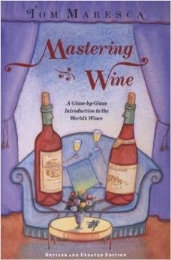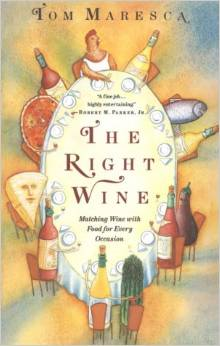I don’t know whether it’s seasonal, or cyclical, or a function of the heat, but lately I’ve been reading more and hearing more about “breathing” wines than I have in a long time. Whatever: If this is a sign of a shift from wines of in-your-face simplicity to wines of some complexity, I’m all for it.
 Breathing, of course, is not a yoga exercise for wines or winedrinkers, but the process of opening a bottle and allowing the wine to oxygenate – breathe – for a period of time. What gets people all worked up and confused are the numerous complications that seemingly simple exercise entails: first, the question of whether and/or which wines should be allowed to breathe at all, then whether they should be allowed to breathe in the bottle or should be decanted, and then for how long.
Breathing, of course, is not a yoga exercise for wines or winedrinkers, but the process of opening a bottle and allowing the wine to oxygenate – breathe – for a period of time. What gets people all worked up and confused are the numerous complications that seemingly simple exercise entails: first, the question of whether and/or which wines should be allowed to breathe at all, then whether they should be allowed to breathe in the bottle or should be decanted, and then for how long.
 Some people even pour the wine back and forth between decanter and bottle a few times. I’m not kidding: The late Martin Gersh, for some years a wine writer for Vogue, was a serious advocate of that procedure. He argued that the accelerated exposure to oxygen it afforded allowed wines to open more rapidly and improved their flavor.
Some people even pour the wine back and forth between decanter and bottle a few times. I’m not kidding: The late Martin Gersh, for some years a wine writer for Vogue, was a serious advocate of that procedure. He argued that the accelerated exposure to oxygen it afforded allowed wines to open more rapidly and improved their flavor.
Everyone, I think, would agree that the whole point of letting a wine breathe is to improve its flavor by allowing it to “open.” And most winedrinkers know what “closed” means in a wine: You pull the cork, you sniff, you sniff again, you sip, and you’re getting nothing, or next to nothing, in nose and mouth. But what people mean by “open” is not always clear.
 I’ve generally found two schools of thought. One says you breathe wines in order to allow them to show their mature flavor: The exposure to oxygen is a super-speed version of what happens over years in the bottle, with the slow penetration of oxygen through the cork. This was Martin Gersh’s theory, that he could by rapid but controlled oxygenation effectually advance the age of a young wine until its flavor approximated that of a mature bottle. The other school holds the seeming opposite: that when you allow a wine to breathe, it becomes fresher, the fruit comes forward, and you get more of its youthful charm.
I’ve generally found two schools of thought. One says you breathe wines in order to allow them to show their mature flavor: The exposure to oxygen is a super-speed version of what happens over years in the bottle, with the slow penetration of oxygen through the cork. This was Martin Gersh’s theory, that he could by rapid but controlled oxygenation effectually advance the age of a young wine until its flavor approximated that of a mature bottle. The other school holds the seeming opposite: that when you allow a wine to breathe, it becomes fresher, the fruit comes forward, and you get more of its youthful charm.
 It’s just possible that both could be true, that different kinds of wine respond to breathing in different ways. But The Oxford Companion to Wine would say rather emphatically that neither is true. Of breathing in the bottle, this authoritative tome says “the wine can take only the most minimal of ‘breaths’, and any change is bound to be imperceptible.” On the authority of Émile Peynaud, The Oxford Companion is equally skeptical of decanting: “the longer it is prolonged – i.e., the longer before serving a wine is decanted – the more diffuse its aroma and the less marked its sensory attributes.” In other words, breathing is a lot of hot air.
It’s just possible that both could be true, that different kinds of wine respond to breathing in different ways. But The Oxford Companion to Wine would say rather emphatically that neither is true. Of breathing in the bottle, this authoritative tome says “the wine can take only the most minimal of ‘breaths’, and any change is bound to be imperceptible.” On the authority of Émile Peynaud, The Oxford Companion is equally skeptical of decanting: “the longer it is prolonged – i.e., the longer before serving a wine is decanted – the more diffuse its aroma and the less marked its sensory attributes.” In other words, breathing is a lot of hot air.
 That should settle the issue, but it doesn’t. My own experience directly and strongly contradicts those opinions. Whatever the authorities may say, breathing does in fact make a difference, often a big one, and almost always for the better. (Fragile older wines are the exception: they can be killed by overlong breathing, and in extreme cases by any breathing at all.)
That should settle the issue, but it doesn’t. My own experience directly and strongly contradicts those opinions. Whatever the authorities may say, breathing does in fact make a difference, often a big one, and almost always for the better. (Fragile older wines are the exception: they can be killed by overlong breathing, and in extreme cases by any breathing at all.)
 When I was considerably younger than I am now, just starting out in wine writing and still feeling my way into wine’s intricacies, Diane and I spent a lot of time trying to understand exactly what breathing did for a wine. In the best scientific, controlled-experiment fashion, we would take two bottles of the same wine and open one several hours before dinner and the other just at dinnertime, or decant one (sometimes immediately before dinner, sometimes at a predetermined length of time earlier) and pour the other from the bottle. We did this with many different types of wine, for different lengths of time. It was fun, and it was very, very informative.
When I was considerably younger than I am now, just starting out in wine writing and still feeling my way into wine’s intricacies, Diane and I spent a lot of time trying to understand exactly what breathing did for a wine. In the best scientific, controlled-experiment fashion, we would take two bottles of the same wine and open one several hours before dinner and the other just at dinnertime, or decant one (sometimes immediately before dinner, sometimes at a predetermined length of time earlier) and pour the other from the bottle. We did this with many different types of wine, for different lengths of time. It was fun, and it was very, very informative.
In almost every case, the wine that had been more exposed to air tasted better to us: richer, fuller, more polished, more generous, sometimes even more developed – that is, tasting more like what we knew an older specimen of the same wine with more evolved flavors would taste like. To be sure, we were using young wines – we were young ourselves and correspondingly impecunious – but they were good wines: small Bordeaux chateaux, Burgundy village wines, Antoniolo Gattinara, Mastroberardino Taurasi, Poggio alle Mure Brunello – all affordable wines in that now-long-gone day.
 Occasionally, to verify that we weren’t deluding ourselves, we had other tasters join us. The results were always the same: everyone agreed that the wine that had breathed was better – richer, more complex, a more intense version of what its sibling bottle tasted like. Even with simpler wines, like Beaujolais and Valpolicella, there was a difference: The fruit might not be any more complex, but it was more vibrant. With wines capable of bottle age, like those I mentioned above, often some of the complexities started to show – nothing like what you would get with a properly aged wine, but more than a simple pop-the-cork-and-pour would give you.
Occasionally, to verify that we weren’t deluding ourselves, we had other tasters join us. The results were always the same: everyone agreed that the wine that had breathed was better – richer, more complex, a more intense version of what its sibling bottle tasted like. Even with simpler wines, like Beaujolais and Valpolicella, there was a difference: The fruit might not be any more complex, but it was more vibrant. With wines capable of bottle age, like those I mentioned above, often some of the complexities started to show – nothing like what you would get with a properly aged wine, but more than a simple pop-the-cork-and-pour would give you.
You can easily try this yourself. Take two bottles of the same wine, one opened for one, two, or three hours or decanted for whatever length of time piques your interest, the other opened and served immediately. As I’ve said in this blog many times already, you only taste with your own mouth. See if breathing the wine makes any difference to you. If it doesn’t, you saved yourself a lot of future fuss. But if you do detect a pleasurable difference, you have added a new dimension to your enjoyment of wine.


